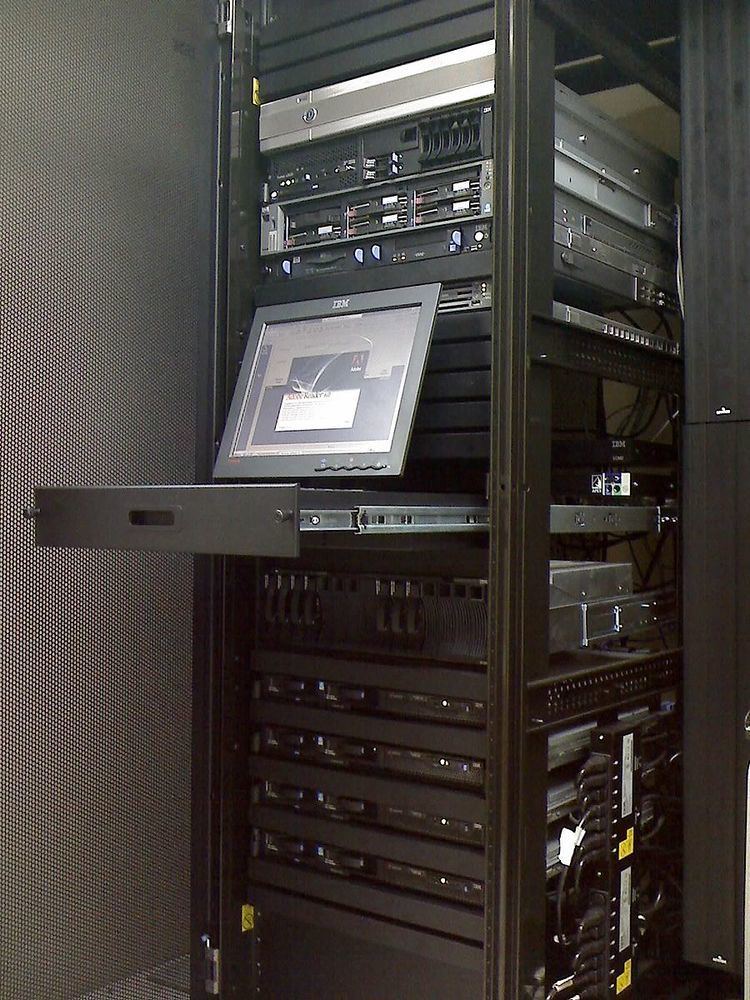 | ||
A colocation centre (also spelled co-location, or colo) or "carrier hotel", is a type of data centre where equipment, space, and bandwidth are available for rental to retail customers. Colocation facilities provide space, power, cooling, and physical security for the server, storage, and networking equipment of other firms—and connect them to a variety of telecommunications and network service providers—with a minimum of cost and complexity.
Contents
Configuration
Many colocation providers sell to a wide range of customers, ranging from large enterprises to small companies. Typically, the customer owns the IT equipment and the facility provides power and cooling. Customers retain control over the design and usage of their equipment, but daily management of the data center and facility are overseen by the multi-tenant colocation provider.
Building features
Buildings with data centres inside them are often easy to recognize due to the amount of cooling equipment located outside or on the roof.
Colocation facilities have many other special characteristics:
Colocation data centres are often audited to prove that they live up to certain standards and levels of reliability; the most commonly seen systems are SSAE 16 SOC 1 Type I and Type II (formerly SAS 70 Type I and Type II) and the tier system by the Uptime Institute. For service organizations today, SSAE 16 calls for a description of its "system". This is far more detailed and comprehensive than SAS 70's description of "controls". Other data center compliance standards include HIPAA (Health Insurance Portability and Accountability Act (HIPAA) audit) and PCI DSS Standards.
Physical security
Most colocation centres have high levels of physical security, including on-site security guards trained for Anti-Terrorism in the most extreme cases. Others may simply be guarded continuously. They may also employ CCTV.
Some colocation facilities require that employees escort customers, especially if there are not individual locked cages or cabinets for each customer. In other facilities, a PIN code or proximity card access system may allow customers access into the building, and individual cages or cabinets have locks. Biometric security measures, such as fingerprint recognition, voice recognition and "weight matching", are also becoming more commonplace in modern facilities. 'Man-traps' are also used, where a hallway leading into the data centre has a door at each end and both cannot be open simultaneously; visitors can be seen via CCTV and are manually authorized to enter.
Power
Colocation facilities generally have generators that start automatically when utility power fails, usually running on diesel fuel. These generators may have varying levels of redundancy, depending on how the facility is built.
Generators do not start instantaneously, so colocation facilities usually have battery backup systems. In many facilities, the operator of the facility provides large inverters to provide AC power from the batteries. In other cases, the customers may install smaller UPSes in their racks.
Some customers choose to use equipment that is powered directly by 48VDC (nominal) battery banks. This may provide better energy efficiency, and may reduce the number of parts that can fail, though the reduced voltage greatly increases necessary current, and thus the size (and cost) of power delivery wiring.
An alternative to batteries is a motor generator connected to a flywheel and diesel engine.
Many colocation facilities can provide redundant, A and B power feeds to customer equipment, and high end servers and telecommunications equipment often can have two power supplies installed.
“Redundancy in IT is a system design in which a component is duplicated so if it fails there will be a backup.”
N+1, also referred to as “parallel redundant”: “The number of UPS modules that are required to handle an adequate supply of power for essential connected systems, plus one more.”
2N+1, also referred to as “system plus system”: “2 UPS systems feeding 2 independent output distribution systems.” Offers complete redundancy between sides A and B. “2(N+1) architectures fed directly to dual-corded loads provide the highest availability by offering complete redundancy and eliminating single points of failure.”
Colocation facilities are sometimes connected to multiple sections of the utility power grid for additional reliability.
Cooling
Cooling within the data center can be done in multiple ways.Typically though, what "cooling" refers to is the removal of heat. Consider the heat you feel coming out of the back of your cable box, laptop or desktop computer. Now consider how much heat is produced from the thousands of servers and other IT equipment inside the data center. In order to keep this heat from damaging the sensitive IT equipment, data center operators utilize a few different technologies including the Computer Room Air Conditioner (CRAC), Computer Room Air Handler (CRAH) and chiller plant. More progressive operators have opted to use conductive cooling. Whereas traditional cooling technologies rely on chilled water systems, which consume and waste a lot of power and water, conductive cooling leverages refrigerant and consumes far less water and energy.
The operator of a colocation facility generally provides air conditioning for the computer and telecommunications equipment in the building. The cooling system generally includes some degree of redundancy.
In older facilities, the cooling system capacity often limits the amount of equipment that can operate in the building, more so than the available square footage.
Internal connections
Colocation facility owners have differing rules regarding cross connects between their customers, some of whom may be carriers. These rules may allow customers to run such connections at no charge, or allow customers to order such connections for a significant monthly fee. They may allow customers to order cross connects to carriers, but not to other customers.
Some colocation centres feature a "meet-me-room" where the different carriers housed in the centre can efficiently exchange data.
Most peering points sit in colocation centres.
Because of the high concentration of servers inside larger colocation centres, most carriers will be interested in bringing direct connections to such buildings.
In many cases, there will be a larger Internet Exchange hosted inside a colocation centre, where customers can connect for peering.
